

| The object is to see if it is possible to build a bark like canoe using paper rather than birch bark. For this experiment an old style Algonquin canoe was chosen as the model. | |
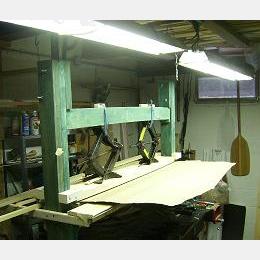
|
A press is constructed to build four sections of paper. Each sections is 35" long and 47" wide. |

|
To connect the sections into one sheet the press is placed on the floor
and extensions added to support the full sheet.
For the finished sheet: Length: 132.5" Weight: 16.5 pounds. Thickness: 3/32 inch (2mm) Paper : 13 pounds and 6 ozs. (includes a few ounces for experimenting). Glue: About 6.5 quarts. Number Layers: 11 Number Strips: About 400 Number Strips placed per day: 10 - 12 strips. |

|
Basswood from a recently felled tree is split into manageable sections for milling lumber as required. |

|
Stem pieces are formed in a jig; the wooden strips have been steamed as an aid in bending. They are keep in the jig during drying. |
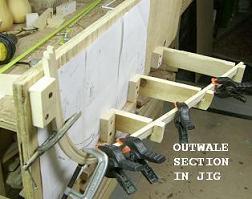
|
The outwale, strips that run along the outside top edge of the canoe, are being formed. For this style of canoe the outwales bow rapidly near the stems. Two pairs of these bent sections and are needed to build the both outwales. |
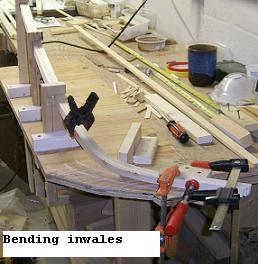
|
The inwales, strips that run along the inside top edge of the canoe, do not require the same amount of bending as the outwales. Two bent sections, plus a center section, are needed to construct each inwale. |
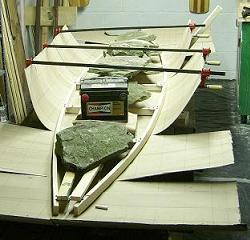
|
A building table is built that supports stakes that run along the outside edge of the canoe. The paper sheet is placed on the table and a building frame is held in place by weights on top of the frame. Note that the gores, vertical slits, have been cut in to the paper. Do to the stiffness of the paper it was necessary to reduce the thickness near the stems. Still the paper fractured during bending at the stems. |
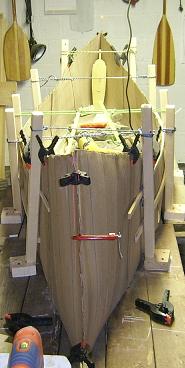
|
The paper has been brought up and held in place with the stakes. The stem piece has not been installed yet. |

|
The gores are closed with lashings (rattan cane). This area will be sealed later. |
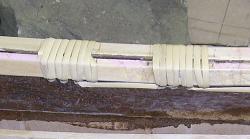
|
The gunwale lashings (rattan cane) are started. At each area a wooden peg is inserted through the outwale into the inwale. Note how the epoxy has turned the tan paper dark brown. |

|
The two main thwarts are installed. For this solo canoe there is no center thwart. |
Previous page................